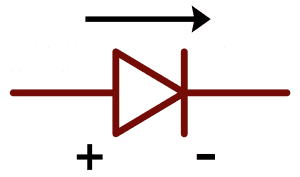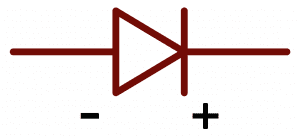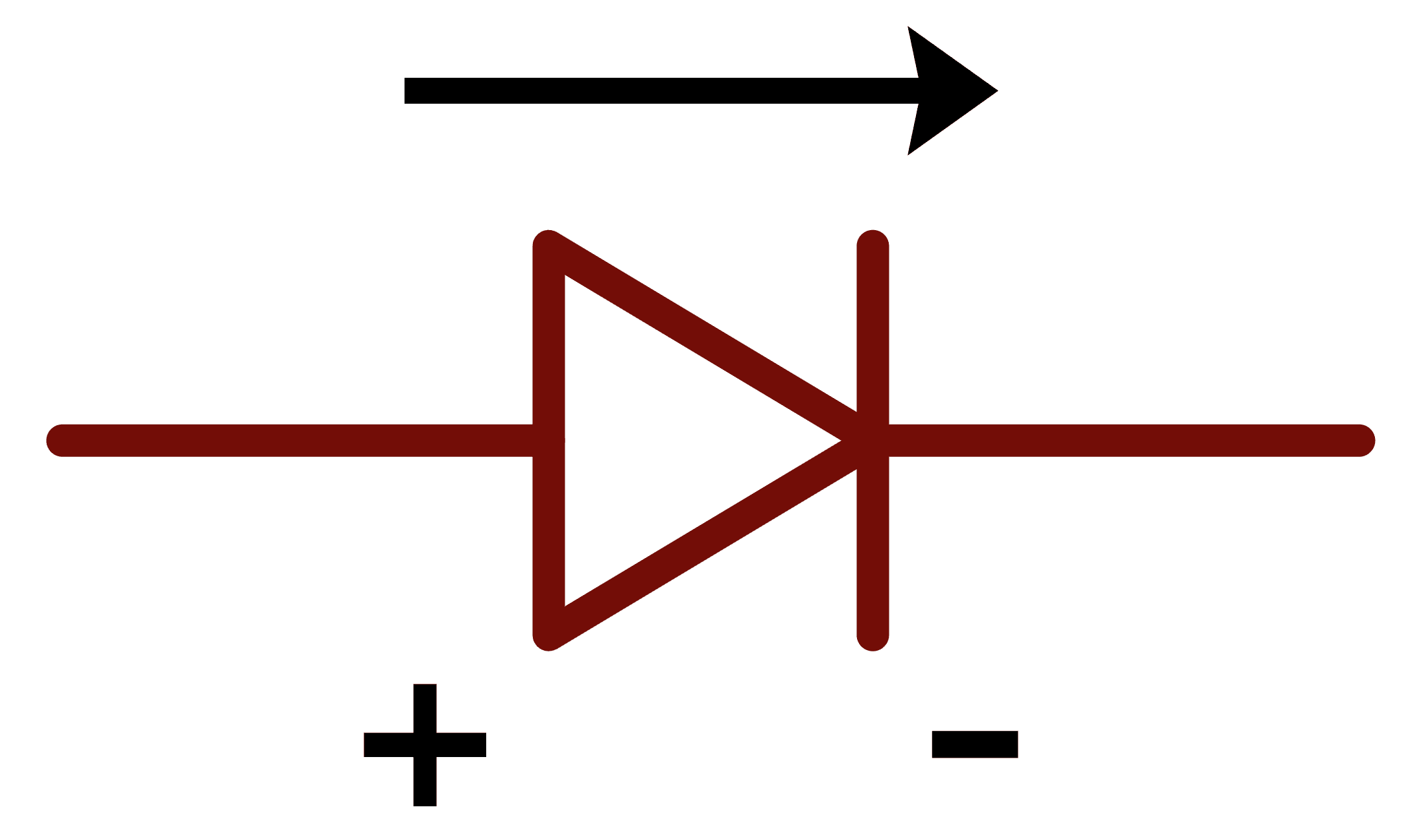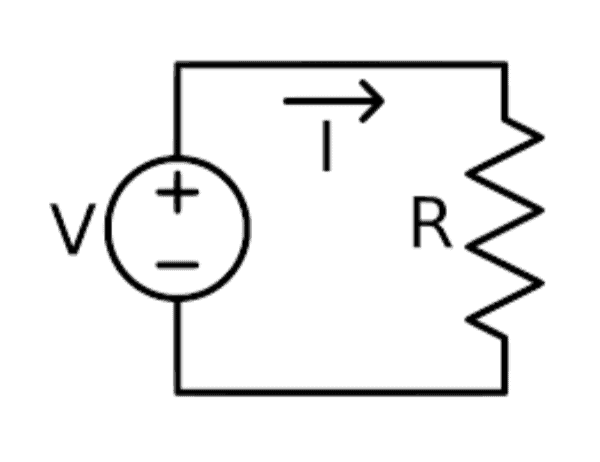A diode is a specialized electronic component that acts as a one-way switch. It conducts electric current in only one direction and restricts current from the opposite direction. A diode is reverse biased when it acts as an insulator and is forward biased when it allows current to flow. A diode has two terminals, the anode and the cathode. Uses for diodes include switches, signal modulators, signal mixers, rectifiers, signal limiters, voltage regulators, oscillators, and signal demodulators.

The voltage applied to the anode is positive with respect to the cathode. Also, the voltage in the diode is higher than the threshold voltage, so it acts as a short circuit and allows current to flow.

If the cathode is made positive with respect to the anode, the diode is reverse-biased. It will then act as an open circuit that results in no flow of current.
What are Diodes Used For?
Reverse Current Protection
A blocking diode is used in some circuits for protection in case there is an accidental reverse connection problem like connecting the DC supply in a wrong way or reversing its polarities. A flow of current in the wrong direction can damage other circuit components.

The figure above shows that the blocking diode is connected in series with the load and with the positive side of the supply. In case of reverse connection, the current will not flow because the diode will be in reverse bias. The load will then be protected against the reverse current. However, if the polarity is correct, the diode will be in forward bias so the load current can flow through it.
Simple Voltage Regulators
A voltage regulator is used to step down the input voltage to the required level and will keep it the same in spite of fluctuations in the supply. It can also be used to regulate the output voltage. A Zener diode is usually used as a voltage regulator because it is designed to work in the reversed bias condition. It behaves like a normal signal diode when in forward bias. On the other hand, the voltage remains constant for a wide range of current when the reverse voltage is applied to it.

In the figure above, the current in the diode is limited by the series resistor connected to the circuit. Since the diode is connected to the positive terminal of the supply, it works as a reverse bias that can also work in breakdown condition. High power rating diode is usually used because it can handle reverse bias above its breakdown voltage. The Zener diode current will always be at minimum if the minimum input voltage and the maximum load current is applied. Given the input voltage and the required output voltage, we can use the Zener diode with voltage approximately equal to the load voltage.
Voltage Stabilizers
The current flowing through the Zener diode is reduced in favour of the load current when the load resistor is connected in parallel to the Zener diode. The amount of current flowing in it is important because it is the key to stabilization. Looking at the current-voltage curve for Zener diodes, you’ll notice a sharp increase above the breakdown voltage which proves that it is best in stabilizing small direct voltages. The current increases while the diode’s resistance decreases. Therefore, the voltage at the Zener diode is almost the same. Usually, a resistor is connected to make sure that the maximum allowable dissipation power is not exceeded.
Converting AC to DC
Diodes are usually used to construct different types of rectifier circuits such as half-wave, full-wave, center-tapped and full bridge rectifiers. One of its main application is the rectification of AC power to DC power.

During the positive half cycle of the input supply, the anode turns positive with respect to cathode. The diode will be in forward bias which then results to flowing of current to the load. However, during the negative half cycle of the input sinusoidal wave, the anode turns negative with respect to the cathode. Thus, the diode will be in reverse bias and no current will flow to the load. The output voltage will be a pulsating DC when both voltage and current at the load side are of one polarity. The load is resistive in the positive half cycle and the voltage across the load resistor will be the same as the supply voltage. The load current flow will be proportional to the voltage applied and the input sinusoidal voltage will be at the load.
How Does a Diode Work?
A diode is considered a semiconductor device that has two leads and functions as a one-way door for electric current. Semiconductors can be conductors or insulators. Thier resistance can be controlled by increasing or decreasing its resistance called doping. Doping is the process of adding impurity atoms to the material.
There are two types of semiconductor materials:
- N-type material – adding amounts of arsenic, phosphorous, antimony, bismuth and other pentavalent elements can produce an N-type semiconducting material. It has extra electrons. Its extra negatively charged particles move from a negatively charged area to a positively charged area.
- P-type material – adding amounts of aluminium, gallium, boron, indium and others can produce a P-type semiconducting material. It has extra holes.
Having holes means the absence of an electron and having a positive charge. Every time an electron moves into a hole, it creates another hole behind it since they move in opposite direction of electrons. Combining the N-type and P-type material forms a P-N junction. You can see the depletion region on either side of the diode junction. This region is depleted of free electrons and holes. Electrons from the N-type side fill the holes on the P-type side.
What is the Depletion Zone?
A depletion region forms when no voltage is applied to the diode so electrons from the N-type material fill holes from the P-type material along the junction between the layers. In that region, N-type or P-type material is returned to its original insulating state. Electricity cannot flow to a depletion region since all holes are filled and there are no free electrons or empty spaces for electricity.

You’ll see the P-N junction when holes move from the P-side to the N-type material and uncover negative charges. Then, you’ll see holes and electrons diffuse to the other side. After that, the depletion region starts to form.
Forward Biased Diodes vs Reverse Biased Diodes

Special Purpose Diodes
Zener Diodes
Zener diodes are composed of heavily doped PN junction that conducts in the reverse direction when a certain specified voltage is reached. It also allows current to flow in either a forward or reversed direction. It is commonly used for surge suppressors, voltage regulation, reference elements and any other switching applications and clipper circuits.
Schottky Diodes
Schottky diodes have a low forward voltage drop but with a very fast switching action. A semiconductor-metal junction is formed between the metal and semiconductor that creates a Schottky barrier. There is a small voltage drop across the diode terminals when a current flows through the diode. The lower the voltage drop, the better the system efficiency and the higher the switching speed. The most common applications of Schottky diode is in radio frequency, a rectifier in some power applications and a mixer.
Rectifier Diodes
Rectifier diodes can be biased or unbiased. The rectifier diode becomes unbiased when no voltage is supplied to it. During this time, the P-side have the majority of charge carrier holes and very few electrons while the N-side have the majority electrons, and very few holes. On the other hand, it becomes forward-biased when the positive terminal of a voltage source is connected to the P-type side, and the negative terminal is connected to the N-type side. It will be in reverse bias when the positive terminal of the source voltage is connected to the N-type end, and the negative terminal of the source is connected to the P-type end of the diode. There will be no current through the diode except reverse saturation current because the depletion layer of the junction becomes broader with increasing reverse-biased voltage. Rectifier diodes are commonly used as a component in power supplies that converts the AC voltage to DC voltage.
Signal Diodes
Signal diodes are commonly used to detect signals. They usually have a low maximum current rating and a medium-high forward voltage. One of the most conventional applications of a signal diode is as a basic diode switch.
Germanium Diodes
Germanium diodes have an intrinsically low forward voltage drop, typically 0.3 volts. Having low forward voltage drop results in a low power loss and a more efficient diode that makes it better in many ways than a silicon diode. It is more important in very low signal environments such as in signal detection from audio to FM frequencies and in low level logic circuits. Germanium diodes have a larger leakage current for germanium at a reverse voltage than for silicon.
Junction Diodes
Junction diodes are one of the simplest semiconductor devices. But unlike other diodes, they don’t behave linearly with respect to the applied voltage. Diodes have an exponential current voltage relationship. It is formed when a P-type semiconductor is combined to an N-type semiconductor creating a potential barrier across the diode junction.
Three Possible “Biasing” Conditions for the Standard Junction Diode
1. Forward Bias – The voltage potential is connected negatively to the N-type material and positively to the N-type material across the diode that decreases the PN junction diode width.
2. Reverse Bias – The voltage potential is connected positively to the N-type material and negatively to the P-type material across the diode that increases the PN junction diode width.
3. Zero Bias – No external voltage potential is applied to the PN junction diode.
Hope this article has helped to give you a better understanding about diodes and how they work. Feel free to leave a comment below if you have questions about anything!






Folks, I have a lawn tractor engine inwhich a diode connected tothe engine’s charging alternator coils melted! ( I believe the ign. switch went bad.) I can buy a new “diode assy.” My question is: how do I connect the new diode in the correct position/direction?? Thanks! Greg